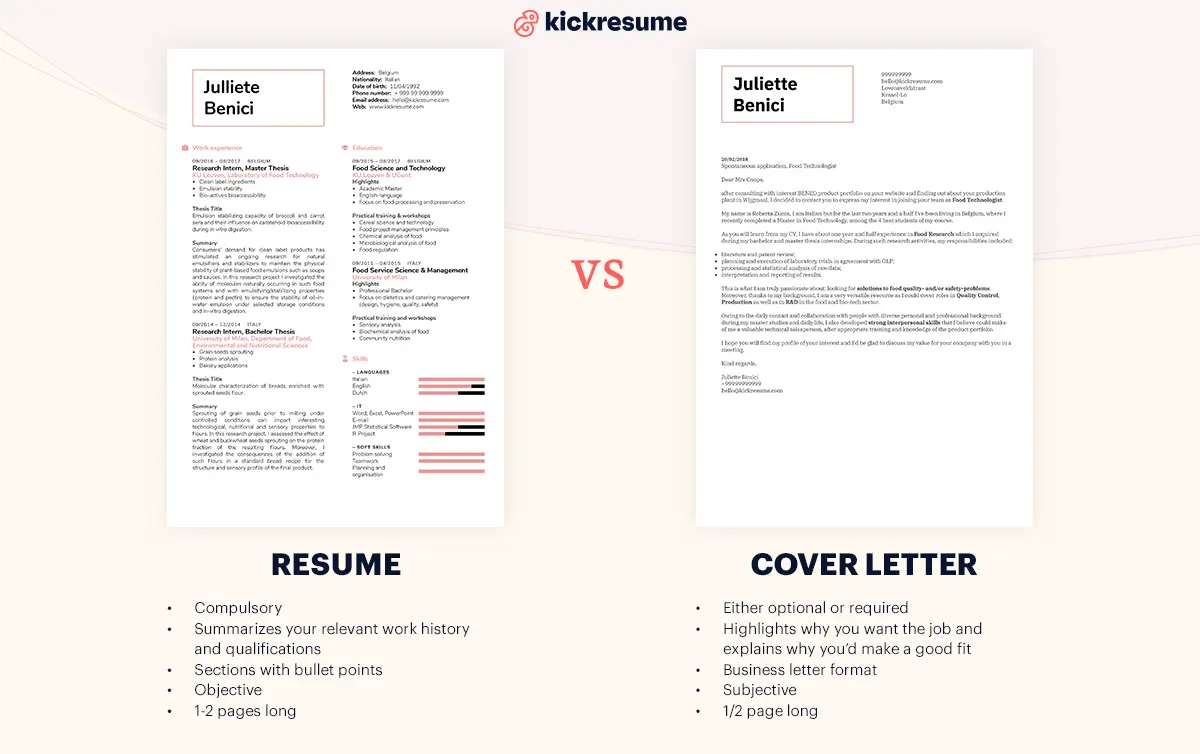
Introduction
A cover letter and resume are two of the most important documents you will need when applying for a job. They work together to give potential employers a complete picture of your skills, experience, and qualifications.
However, it is important to understand the difference between the two documents and how to use them effectively.
A cover letter is a one-page letter that you send to a potential employer along with your resume. It is an opportunity to introduce yourself, explain why you are interested in the job, and highlight your most relevant skills and experience.
Your cover letter should be tailored to each job you apply for. Be sure to mention the specific job title and company name in the first paragraph. You should also highlight the skills and experience that are most relevant to the position.
Here is a basic outline for a cover letter:
- Introduction: State your name and the position you are applying for. Explain why you are interested in the job and the company.
- Body: Highlight your most relevant skills and experience. Be sure to use specific examples and examples.
- Conclusion: Restate your interest in the job and thank the hiring manager for their time and consideration.
Tips for writing a cover letter:
- Be specific and concise. Your cover letter should be no more than one page long.
- Use keywords throughout your letter. This will help your cover letter get noticed by applicant tracking systems (ATS).
- Proofread carefully before submitting your letter.
A resume is a multi-page document that summarizes your work experience, education, and skills. It is a more detailed overview of your qualifications than your cover letter.
Your resume should be formatted in a clear and easy-to-read way. Use standard fonts and margins, and be sure to list your information in reverse chronological order.
Here is a basic outline for a resume:
- Contact information: Include your name, email address, phone number, and mailing address.
- Summary: This is a brief overview of your skills and experience.
- Work experience: List your previous jobs in reverse chronological order. Be sure to include the company name, your job title, and your dates of employment.
- Education: List your educational background in reverse chronological order. Be sure to include the name of the institution, your degree, and your dates of attendance.
- Skills: List your relevant skills and abilities.
Tips for writing a resume:
- Be specific and concise. Your resume should be no more than two pages long.
- Use keywords throughout your resume. This will help your resume get noticed by applicant tracking systems (ATS).
- Proofread carefully before submitting your resume.
How to use a cover letter and resume together
Your cover letter and resume should work together to give potential employers a complete picture of your skills, experience, and qualifications.
Your cover letter should introduce yourself and highlight your most relevant skills and experience. Your resume should provide more detailed information about your work experience, education, and skills.
When submitting your job application, be sure to include both your cover letter and resume. This will give potential employers the best chance to learn about you and your qualifications.
Example:
Here is an example of how to use a cover letter and resume together:
Cover letter:
Dear [Hiring Manager name],
I am writing to express my interest in the [position name] position at [company name]. I have been following your company for some time now, and I am very impressed with your work in the [industry] industry. I am confident that my skills and experience would be a valuable asset to your team.
In my previous role at [previous company name], I was responsible for [list of responsibilities]. I have a proven track record of success in [list of accomplishments]. I am also skilled in [list of skills].
I am passionate about [industry] and I am eager to contribute to your team's success. I am confident that I have the skills and experience necessary to be successful in the [position name] role.
Thank you for your time and consideration. I look forward to hearing from you soon.
Sincerely,
[Your name]
Resume:
[Your name]
[Your address]
[Your phone number]
[Your email address]
Summary
I am a [number] year

Cover Letter vs Resume: Differences, Comparison, Examples - Source: blog.kickresume.com

Resume vs. Cover Letter: What's the Difference? | Indeed.com - Source: www.indeed.com

Cover Letter Vs Resume Comparison Table by JobSearchBible.com | Cover - Source: www.pinterest.co.uk
What Is Cover Letter Vs Resume, Building a Resume and Cover Letter, 4.83 MB, 03:31, 21,736, WorkBC, 2021-01-05T16:21:39.000000Z, 2, Cover Letter vs Resume: Differences, Comparison, Examples, 1200 x 754, png, , 3, what-is-cover-letter-vs-resume
What Is Cover Letter Vs Resume. WebThe most obvious difference is that the cover letter looks different than the resume. The cover letter is a business letter, or even if it's the shorter, more casual email.
The key to a successful job search is a strong resume and cover letter.
Cover Letter vs Resume: Differences, Comparison, Examples
Building a Resume and Cover Letter

Source: Youtube.com
Difference Between Cover Letter and CV - what is the difference between a cv and cover letter

Source: Youtube.com

0 Comments